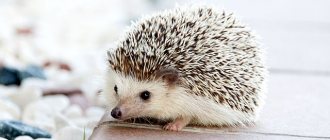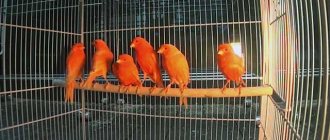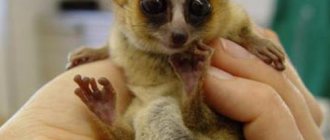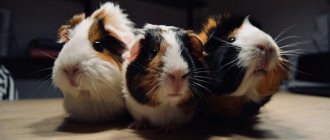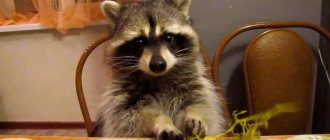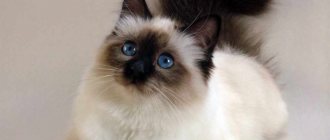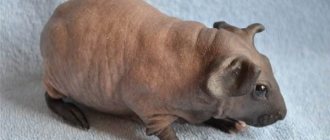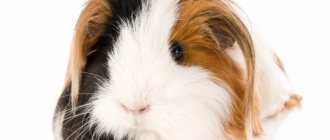The Abyssinian guinea pig is the perfect furry friend
These rodents first appeared in Brazil as a result of a natural mutation.
The Abyssinian guinea pig gained popularity in Europe in 1861. It got its name “rosette” due to a genetic mutation, as a result of which the fur began to grow in a circle from the center, with 8-12 such swirls on the body. The presence of a rosette on the nose is welcome, but its absence is not a disadvantage. The modern rodent differs from its ancestors, being a cross between Peruvian and smooth-haired guinea pigs. The true Abyssinian breed is no longer found in nature.
Modern animals have several features:
Color
Rosette guinea pigs can have either a single color or a combined color.
The most common are brown, white, golden, chocolate.
There are several groups of the most common colors:
- agouti - close to the original color of wild animals;
- self - solid color of white, red, black, cream;
- tortoiseshell or combined;
- piebald, occurs more often than others.
Size
The size of an adult Abyssinian reaches 28 cm.
Adults reach a size of 25-35 cm. Weight ranges from 800-1200 g.
Lifespan
They usually live 8 years, but with care and proper care, their lifespan can almost double and reach 10-14 years.
Character
Rosette guinea pigs are extremely friendly and quickly get used to people. As a sign of tenderness and trust, they can lick the owner’s fingers or make rattling noises while sitting in their arms. The animals have keen hearing and can distinguish the steps of the owner who has not yet entered the apartment. At the same time, rodents are quite shy. A sharp, unexpected sound can cause panic.
Advantages and differences from other breeds
The unique features of the breed are the rosettes in which the long fur is wrapped.
Although the fur of the rosette guinea pig is the main and most noticeable feature of the breed, other features are also distinguished:
- It has a strong build, shaped like a square.
- She is symmetrical, despite a certain dishevelment, the rosettes break her body into squares.
- Smooth ridges are formed at the junctions of the rosettes.
- Hard coat that stands on end, the length of the coat is 3-3.5 centimeters.
- Sideburns on the cheeks due to the growth of fur in different directions.
- Ears drooping in waves.
Abyssinians may have almond-shaped eyes, although this is not acceptable in other breeds.
average life expectancy
Unlike other rodents that live 2-3 years, guinea pigs are considered long-lived, which is what captivates future owners.
The small animals, which originated in South America, gained popularity around the world after the visit of Europeans, who transported them to other continents. Numerous breeding works, which made it possible to develop new species, shortened the natural life expectancy. A pig living in the wild can live up to 10 years. In this case, the duration depends entirely on external environmental conditions (climate, predators), so it can be 5 times lower.
At home, guinea pigs live from 5 to 7 years.
Lifespan depends on many factors, most of which are determined by proper care.
IMPORTANT! The age record was set by an English rodent, which was slightly short of the 15-year mark (it was 2 months short).
Conditions of detention
Representatives of this breed are very mobile, so their cage should be spacious. It is a good idea to install wooden covers on the cage bars. Sawdust or hay is placed at the bottom of the cage. You can use granular filler, but large ones so that particles do not enter the respiratory tract. A salt pebble attached to the grill will make your pet very happy.
Caring for a rosette guinea pig is quite simple.
Clean the cage 1-2 times a week, since the sockets have practically no smell.
This variety tolerates the cold quite calmly. I can even live outside, provided the winter is mild. But heat has a bad effect on animals. Animals are also afraid of drafts and dampness.
The characteristics of the animal's fur make it easier to care for. It is enough to comb once a week to remove lost hair.
Bathing is a lot of stress for an animal. If the contamination is minor, it is better to wipe the dirty area with a damp cloth. If washing is unavoidable, choose a basin with a non-slip bottom. Set the temperature to moderate.
The animal is washed only up to the neck area to avoid water getting into the eyes and ears.
After bathing, dry the coat with a hairdryer.
Rodents need to have their claws trimmed. This is done with special scissors at home or at the doctor's office.
Claw care
Nail trimming is an important procedure. The animal's paws can become deformed if it is not regularly freed from the processes that interfere with its vital functions. The procedure is carried out twice a year, starting from one year of age.
Tools
To trim your guinea pig's claws you will need:
- nippers - it is preferable to use special ones for animals, but children’s ones are also suitable; styptic powder or corn starch; hand towel.
Nail trimming
Before the procedure, all equipment must be laid out so that you can quickly access it. Then the pet is removed from the cage in a calm mood and wrapped in a towel. Next, the pig is placed on your lap and given time to recover a little, you can treat it with a tasty treat. After the animal has calmed down, the claws are cut off from its paws one by one, being careful not to touch the eponychium. If a blood vessel is touched, you must immediately stop the bleeding using powder or starch.
Nutrition
All individuals of this species love to eat deliciously and a lot.
The rosette guinea pig is almost omnivorous. Mostly they eat hay or grass. Also, the pet will not refuse fresh vegetables and fruits. They will eat whatever you give them, but each of them has their own personal preferences. It is necessary to add branches of fruit trees to the diet to prevent excessive growth of the front teeth.
They love to eat a lot, so they are often obese!
A special food has been developed especially for guinea pigs, including all the necessary ingredients. You can buy it at any pet store. The animals eat it with pleasure.
Don't forget to make sure there is always fresh water in the cage.
However, despite the simplicity of feeding, there are foods that should not be given:
- Animals can be poisoned by green onions or leeks.
- Legumes, like cabbage, in large quantities can cause bloating and diarrhea.
- Potatoes, due to their starch content, are not digestible by the body.
- Radishes or radishes can inflame the mucous membranes.
- Rhubarb and sorrel contain large amounts of acid, which is toxic to animals.
- Fruits high in sugar, such as apricots, cherries, plums, and exotic varieties, can cause severe diarrhea.
- Animal products. These rodents are vegetarians and should not be given meat or fish.
- Like any other animal, you should not feed it candy, marshmallows or other sweets.
- Rodents, like humans on a diet, should not eat bread, fried, smoked, or salted foods.
Care during pregnancy and lactation
The female requires special care during pregnancy and nursing. Pregnancy lasts up to 70 days, during which time pigs are susceptible to various diseases and the risk of death is high.
Recommended for this period:
- ensure silence; eliminate bright light; handle your pet as little as possible; maintain the animal’s physical activity, do not cancel walks; give the pig granulated food and fresh, juicy foods, avoid changes in diet; give only fresh, clean water, ensure that the drinking bowl is filled; carry out additional fortification.
Guinea pig and other animals in the house
The Abyssinian is not a pugnacious animal. Conflicts can only arise with new representatives if a nest group has already been formed. Although even if a new male appears, fights are very rare, animals prefer to resolve the conflict by talking - whistling and threatening poses.
If there are only 2 pigs, they will be inseparable in all fun and movement.
As for other pets, pigs will not be aggressive, but it is worth considering some possible interactions with popular pets:
Rosette pigs are friendly and cheerful
- Cats. If you buy a pig and a cat at the same time as children, friendly relations will be established between the animals. If the cat is already an adult, problems may arise. For cats, a rodent is prey, so it is worth protecting the pig from stress and placing the cage in a place that is difficult for the cat to reach. However, there are many examples of friendship in such a situation.
- Dog. The larger the animal, the more dangerous it is for the rodent. The friendliest attempt to play may result in a rodent breaking a couple of bones. It's better not to let her walk unattended.
- Parrot. The ideal friend and neighbor for your pig. Budgerigars love to ride on the back of a rodent and fuss in the fur.
- Rodents. The likelihood of competition is high. Of all the varieties, it is recommended to keep dwarf rabbits with pigs. Their size, habits, and tastes are similar enough for them to live peacefully together.
Pet character
Abyssinian pigs have a calm character. They rarely decide to bite people and almost never show aggressiveness. But this does not mean at all that the animal is not able to stand up for itself. Just the opposite: two females can begin to sort things out, and the males will even get involved in a fight. If the animals are related by blood, then most likely they will live well with each other. By the way, this breed is classified as difficult to breed. The rosette pig almost always gets along with people and happily “communicates” with its beloved owner. As long as they live nearby, they make a person happy!
Health and illness
One of the benefits of rosettes is good health.
Although they rarely suffer from infectious and colds, it is necessary to carry out examinations of the animal.
Rosette breed guinea pigs are considered unpretentious and low-susceptibility animals to diseases.
Some signs of disease:
- Refusal of food.
- Changes in behavior.
- Scaly skin.
- Stiffness and coarseness of wool.
- Enlargement (bloating) of the chin.
- Apathy.
If one of these signs appears, you need to show your pet to a doctor to prevent the development of the disease.
The pig may become apathetic and even get sick from lack of attention.
Eye care
Caring for guinea pigs includes checking the animal's eyes daily. In a healthy guinea pig, they are clear, clean, and without discharge. Redness of the cornea, swelling and other abnormalities indicate diseases. If there are no obvious reasons for the inflammatory processes (no drafts, etc.), and the symptoms do not go away, the mumps should be shown to a doctor.
Guinea pigs are susceptible to a variety of eye diseases:
- Dermoid – located on the cornea and requires surgical intervention. Anophthalmia and microphthalmos are severe developmental defects. Blepharitis is a consequence of a fungal infection and is treated with medication. Damage to the eyelids due to fights or mechanical contact. Conjunctivitis - treatment requires eliminating the root cause (most often a lack of vitamin C). Orbital bulge is a pea-sized bump that does not require treatment. Corneal opacities.
Breeding and reproduction
Rosette guinea pigs are difficult to breed. Females are allowed to mate at the age of at least 5 months. The choice of future parents is taken very seriously. Not only the pedigree is assessed, but also the data of the animal itself. But even the best selection can result in smooth-haired offspring. Crossing with other types of pigs will also not give the desired breed. The offspring will lose the natural trait.
Rosette guinea pigs often give birth to smooth-haired babies.
Crossing Abyssinian guinea pigs with long-haired breeds is unacceptable. The offspring appears with a completely indistinct type of coat.
Compliance with the breed is assessed in animals at the age of 20 weeks. In younger pigs, the rosettes are not clearly expressed and may lie close to the body. Individuals are rejected if the number of rosettes is less than 8 and more than 12, as well as if the wool is smooth and the combs are weakly curled. If there are many cubs in the litter with such defects, you will have to change the male, and in some cases the female.
Description of the breed
According to the standard, all rosettes of Abyssinian wool grow from one point. The eight main sockets are arranged as follows:
- on each side of the body the rosettes are on the same line and at the same distance from the collar and sacrum,
- on the shoulders strictly above the paws,
- rosettes on the hips form a circle,
- The rosettes located on the sacrum should not intersect.
Abyssinians may have additional rosettes on the tummy and nose, and one on the shoulders.
However, additional rosettes should not disturb the basic coat pattern. Rosettes on the nose are an indicator of the high-breeding of the animal.
The Abyssinian guinea pig has a very thick coat. Smooth fur is allowed only on the tummy. Abyssinians with agouti and black coats have coarser hair. Pigs have a medium length body, deep shoulders and croup. Paws are straight. The muzzle is neat, with pronounced sideburns made of long hair, a mane between the ears, and a kind of collar around the shoulders.
Price
Show guinea pigs are judged on the quality of their rosettes. A perfectly round shape, a dotted center, even ridges at the joints - these qualities will bring victory, and accordingly will raise the price of the offspring. The cost of such an animal exceeds 3,000 rubles. In a nursery, a purebred Abyssinian of a lower class will cost you 1000-2000, and without a pedigree you can buy an animal for a little less than 1000 rubles. The price of the animal will not affect its character in any way, only its exterior.
When purchasing, it is important to pay attention to the absence of scratches and bald spots. The eyes of a healthy animal are clear and without discharge. It is also advisable to look at the parents and conditions of detention. It is better to buy a pet from professional breeders to minimize the chance of buying a sick animal.
The rosette guinea pig is excellent as a pet. They rarely get sick, have a friendly character, are unpretentious in food and easy to care for. This pet is suitable for almost everyone.
Additional factors affecting health
Besides food, there are other factors that affect the health and lifespan of guinea pigs. If their cage is too small, they will have little room to run around. With a lack of activity, their muscles will not develop properly, and their overall fitness will be far from healthy. Regular cage cleaning also promotes good health.
In case of illness, the owner should immediately contact a veterinarian. It is also recommended that guinea pigs be weighed weekly, as weight loss is the most common and common symptom of a disease or disorder. Besides weight, other symptoms may include shortness of breath, heavy breathing, sneezing, lethargy, diarrhea, and blood in the urine. Prompt attention to these types of health problems will certainly increase your pig's possible lifespan and allow him to reach his full potential.
Abyssinian colors
The main requirement for color is color saturation, brightness and shine of the coat. Guinea pigs can be:
- Red,
- Black,
- Two-color,
- tricolor,
- Agouti,
- Cherepakhov,
- White-gray,
- Dirty white
- White,
- Selfie.
White animals can have both dark and red eyes. The most common colors are red and white and white and black. All motley animals have patches of red or black hair all over their bodies. If there are more red hairs, then the pigs are classified as light; if there are more black hairs, then they are classified as dark. Abyssinian tortoiseshells should have clearly defined boundaries between their black and red markings.
Tortoiseshell, as well as the original variegated color, are very rare in the breed today.
According to the standard, tri-colored or white-tortoiseshell animals must have pronounced spots of each color, located in a chaotic order. Chocolate color is allowed instead of black. The solid color of the selfie is officially recognized only by the English standard and allows for black and red color forms. Roan, blue roan and strawberry colors are rarely found in animals. Typically, animals of these colors cost five to seven times more than ordinary purebred Abyssinians. Often, breeders pass off colors that are similar to them, but less expensive, as valuable. Under the photo you can see the description of the color as variegated, but in reality the color is tricolor and has blurred boundaries of the spots.
Novice breeders and hobbyists are not always able to see the differences between colors and pay a lot of money for a completely ordinary animal.
Features of breeding Abyssinians
The Abyssinian breed has its own disadvantage - it is difficult to breed. Rosette guinea pigs cannot be crossed with representatives of other breeds - the structural features of the coat are lost and the babies turn out to be outbred. For breeding, it is important to have not only a very purebred male, possessing all the characteristics of a real Abyssinian, but also passing on these characteristics to his offspring. Some males may have a bright appearance, but have a weak genotype and the babies are produced with weakly expressed rosettes. Most often, females do not pass on their type, but in combination with a strong male, the offspring is brighter.
Another danger is that having the perfect pair with the right number of sockets can result in babies with excess sockets. And this is no longer strictly acceptable in the breed. Therefore, if two litters have cubs with an excess of rosettes, it is recommended to change the female. It is also not recommended to crossbreed animals that have one of the breed defects. In most cases, it will be passed on to descendants and it will be very difficult to get rid of it in the future.
These cute little animals are very popular among pet lovers.
Their unpretentiousness in food and easy care make them very convenient to keep.
Everything a pig needs
– a small, cozy cage, tasty food, attention and care from the owner.
There are several varieties of guinea pigs, but the most original among them, the most luxurious, are, of course, rosette guinea pigs
.
Appearance
All pigs are adorable, but the unusual and funny appearance of the Abyssinians cannot help but make you smile.
As a result of mutation, their fur changes its direction and forms rosettes
, which gave the name to the breed.
The hair in these places grows around the circumference, forming a funnel.
The rosettes are located evenly along the animal’s body, giving the pig a hilarious look.
Especially appreciated
lovers of the classic rosette on the nose.
Choosing and arranging a home
A cage (the size varies) or a terrarium (aquarium) can be used for maintenance. Both maintenance methods have their pros and cons. Inside the dwelling there must be: a shelter house, a drinking bowl, and a feeding trough. A bedding of sawdust is laid at the bottom of the dwelling. Important points when choosing a home are:
- cell size;
- home safety, especially the floor;
- ease of cleaning and disinfection.
Cage or terrarium
The first question when choosing a home is the choice between buying a terrarium or a cage.
class="table-bordered">
In fact, pets can feel equally at home in any home if it is cleaned in a timely manner and the animal has enough food. The bottom of the structure must be solid so that the animal does not damage its paws. The floor is sprinkled with sawdust in a layer of 1–1.5 cm, which must be changed regularly.
What's needed inside
Inside the home there must be:
- house;
- drinking bowl;
- feeder
The height of the cage should be about 30–40 cm, although it is not the most important parameter. Since the pig loves to walk, the length of the cage is more important for it - at least 100 cm. Inside the cage there should be a house - a small structure in which the animal can hide and store supplies there, like in a hole.
Video: what should be in a guinea pig's cage
The dimensions of the house are 20x50x20 cm. Windows are not required. The cage also contains a feeder for grain feed, a manger for hay and a drinking bowl. The hay can be located outside the cage, but in such a way that it is convenient for the guinea pig to get it.
Pigs living in a large cage organize a toilet in one of the corners, away from contact with food. This is convenient because you can clean only the toilet every day, and change the rest of the litter as it gets dirty.
Did you know?
The largest guinea pig festival takes place in Peru.
Representatives of different breeds take part in it. With the help of contests and competitions, they establish the fastest, largest, and most fashionable pig. And there is even a competition for the most delicious pig. Abyssinians take care of their fur using sand. But the constant presence of a sand bath will only lead to the pet actively marking the contents of the bath, so it can be placed for a day, a couple of times a week.
Where to put it in the room
The cage should not be placed in a draft; it is also better to place it away from heating appliances. It is optimal to place the cage at a distance of at least 40 cm from the walls and heating system. The pig's room should not be exposed to direct sunlight - this can negatively affect the pet's vision.
How many individuals can be kept together?
In the wild, these animals live in small flocks of 5–10 individuals; they build burrows and coexist peacefully in the same territory. In cages, they often live alone, so it is difficult to say unequivocally about the benefits of one or another option.
Important!
Abyssinian guinea pigs are pugnacious, so it will not be possible to place two boys in the same cage, since they will fight for leadership.
Breeders are clear on one thing: if you decide to expand the social circle of an adult pet, then you need to “preliminarily” make friends with both pigs. This process can take several months and is not always successful. Young animals from the same litter, familiar from childhood, get along best.
The Abyssinian pig does not require special maintenance conditions, with the exception of caring for the coat, which needs to be combed regularly. The food should be high in calories and balanced, the cage should be comfortable and clean, and there should be enough water.
Grooming
Once a week, the wool is wiped with a damp cloth, thus removing dead fibers and possible contamination. The fur is combed with a special comb, which is sold in abundance in pet stores. The working part of the comb-brush should be made of soft plastic material so as not to damage the delicate skin of the pet.
Care of claws, teeth, ears
The growth of teeth in a rodent does not stop throughout its life. To grind them down, young tree branches are included in the diet. If there are not enough branches, unsharpened teeth can damage the cheek. To eliminate the defect, you will need the help of a veterinarian. In nature, claws wear down while running and searching for food. Since the cage limits active running, the claws do not have time to wear down and can cause anxiety in the guinea pig. Regular nail trimming will help in this situation.
The ears must be wiped with a soft cotton swab treated with an antibacterial agent. Usually, pigs' ears are clean, without plaque or damage to the skin. But if you notice the formation of a dark coating or that the pig has begun to actively itch, then it probably has a tick and should definitely be shown to a veterinarian to clarify the diagnosis.
Did you know?
Guinea pigs need vitamin C, but their body does not produce it, so it is necessary to provide it in their diet. Vitamin C is found in rose hips, currants, parsley, yellow and red sweet peppers.
Cleaning the cage
Video: how to clean a guinea pig's cage
